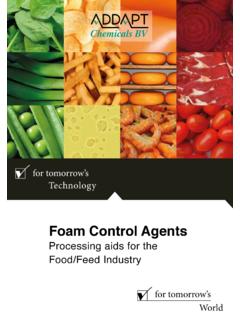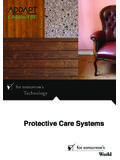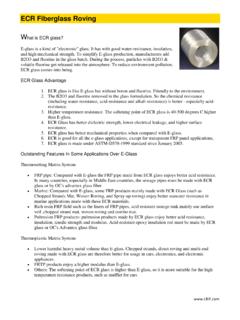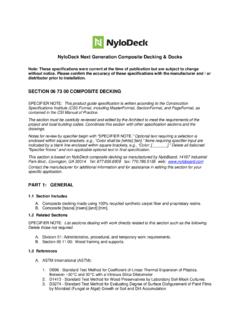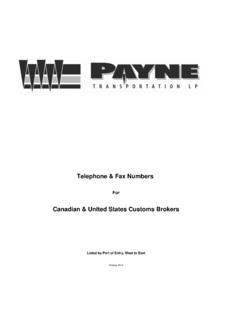Transcription of Neutralizing Agents - ADDAPT Chemicals BV
1 Chemicals BV. R2 R2. for tomorrow's H N. OH. R3 N. OH. Technology R1 R1. CODIS 95 & CODIS BIO. Neutralizing Agents for tomorrow's World 2. Contents 1. Introduction 4. 2. Typical properties CODIS 95 & CODIS BIO 4. 3. Performance benefits CODIS 95 & CODIS BIO 5. 4. FDA-status 5. 5. Performance - Water based systems 5. Amine comparison - primary/secondary 5. Yellowing 5. Cobalt-leaching 5. Nitrosamine formation 6. Wet adhesion - Early water resistance 6. Amines evaluated 6. Experimental 6. Results 6. Discussion 6. 6. Performance - Solvent based systems 7. Solvent based ALKYD paint - Test formulation 7. Gloss development and contrast ratio 8. Yellowing in the dark 9. Drying time 9. K nig Pendulum Hardness 10. 7. Health, Environmental and Safety issues 10. 3. 1. Introduction Amines are used in emulsion polymerisation to provide mechanical stability of resultant dispersions and also in coatings manufacture to assist with pigment dispersion, grind stability if dispersing pigments into polymer dispersion and also pH buffering of dispersion coatings.
2 Ammonia is the most commonly used amine, being low cost, but is highly odorous and has high volatility resulting in pH instability. To overcome these disadvantages formulators have looked at successfully incorporating various Alkanol-amines. In addition to lower volatility and lower odour, these Alkanol-amines also allow superior corrosion resistance, VOC reduction in formulation, excellent pH. buffering and very good pigment dispersion properties. After application of the wet coating, the pH-adjusting agent MUST either, at least partially, evaporate from the film in order to promote the coalescense of the resin binder and to avoid poor early water resistance or become completely inert in the resulting coating film. ADDAPT Chemicals BV now markets CODIS 95, a proprietary blend of Alkanol-amines with an active content of 90%. This is an almost colourless liquid with a low viscosity, that remains liquid at temperatures below -10 C and withstands >5 freeze/thaw cycles at -15 C.
3 It is an excellent pH-buffer with emulsifying properties. Additionally ADDAPT Chemicals BV markets CODIS BIO, a multifunctional Neutralizing agent for Ecolabel certified paints. It enhances compatibility with pigments, wetting and flash rust inhibition. It is based on renewable components, VOC/SVOC free and without hazardous labelling. 2. Typical properties CODIS 95 & CODIS BIO. ADDAPT CODIS 95 and CODIS BIO are proprietary blends containing Alkanol amines in water. All constituents are EINECS, TSCA, ENCS, AICS, DSL, ECL and PICCS registered. CODIS 95 CODIS BIO. Appearance Clear, colourless liquid Clear, colourless liquid Colour (max.) 15 Hazen 25 Hazen Active content 90% < 55%. Water content - - Freezing point < -10 C < -10 C. Freeze/Thaw stability > 5 cycles @ -15 C > 5 cycles @ -15 C. pH (1% aqueous solution, 20 C) < < Density at 20 C - g/cm 3. - g/cm3. 4. 3. Performance benefits CODIS 95 & CODIS BIO.
4 CODIS 95 CODIS BIO. Very good, cost efficient pH-buffer Very efficient Neutralizing agent Cost efficient Co-dispersant Improves tinting strength Enhances wet-scrub resistance Improves storage stability Excellent early water resistance Improves open-time In-can corrosion protection (flash rust) In-can corrosion protection (flash rust) Low odour No odour Low VOC - medium volatility No VOC/SVOC. Non-yellowing Non-yellowing Effective CO2 scavenger > 75% biodegradable Very good emulsifying properties Aerobic and anaerobic biodegradable Allows emulsification of > water in LABEL FREE! solvent based systems 4. FDA-status CODIS 95 and CODIS BIO are in compliance with FDA regulations for direct and indirect food contact: Section , Section and and Section Additional information about other clearances is available on request. 5. Performance Water based systems Amine comparison primary/secondary/tertiary Amine Composition Comments CODIS 95 Blend of Alkanol-amines in water Non-secondary Amines CODIS BIO Proprietary blend Tertiary Amines AMP 95 2-amino-2-methyl-1-propanol Primary amine - < 7% sec.
5 Amine ADVANTEX 2-(n-Butylamino)ethanol Secondary Amine Ammonia NH3 Primary Amine Yellowing To test for yellowing CODIS 95 and CODIS BIO were put in a beaker glass and exposed to air at room temperature. No change in colour was observed over a period of 2 month. Further CODIS 95 and CODIS BIO were added at a level of to neat Styrene/Acrylic, Acrylic, VA/Acrylic and VA/VEOVA emulsions. Samples were stored at 50 C for 1 month. Again no discernible yellowing was observed. Cobalt leaching The leaching of Cobalt from tungsten-carbide tools can shorten tool life and the presence of Cobalt in the used fluid can lead to dermatitis and/or inhalation problems for exposed workers as well as cause problems in waste water disposal. CODIS 95 exhibits minimal Cobalt leaching. 5. Nitrosamine formation Nitrosamines and especially N-Nitrosamines are considered to be very carcinogenic. Secondary (Alkanol)-amines are the most potent to form N-Nitrosamines.
6 These N-Nitrosamines are readily formed by the reaction of secondary (Alkanol)-amines with Nitrites or Nitrogen Oxides. Germany instituted regulations in the 1990's that prohibited the use of secondary amines in metalworking fluids. Both primary and tertiary amines can be used in metalworking formulations and metal primers with little risk of Nitrosamine build-up. Wet Adhesion Early water resistance Since the introduction of AMP 95, other Alkanol-amines have entered the market place; all claiming to have performance benefits. These Alkanol-amines, along with ammonia, were assessed for film resistance properties in Revacryl DP5530 (ex-Synthomer). Amines evaluated Amine Composition Comments CODIS 95 Blend of Alkanol-amines in water Low odour, medium volatility CODIS BIO Proprietary formulation in water No odour, non volatile AMP 95 2-amino-2-methyl-1-propanol Low odour, slow volatility ADVANTEX 2-(n-Butylamino)ethanol Slow odour, very slow volatility Ammonia NH3 Strong odour, fast volatility Experimental Each amine was added at addition level to neat Revacryl DP5530 (ex-Synthomer).
7 Films were then applied at 100 microns wet film thickness onto degreased cold rolled steel panels. Panels were dried for 15 minutes at 60 C then 16 hours at room temperature. Panels were then soaked in tap water for 48 hours. On removal from water, panels were patted dry and a Cross Hatch Adhesive Tape Pull- Off test performed. Results Amine Wet adhesion (% film removed). CODIS 95 0. AMP 95 100. ADVANTEX 60. Ammonia 0. Discussion It is evident that amine choice has a major effect on wet adhesion of the polymer film onto cold rolled steel in this instance. Excellent results were obtained with Ammonia and CODIS 95. It is believed this is due to volatility of each amine under test, with lower volatility amines still being present in the film and imparting water sensitivity, in combination with a function of neutralisation of carboxylic groups present in the polymer. 6. 6. Performance Solvent based systems The ability to incorporate high levels of water in solvent based Alkyd paints is shown in the following section where the performance of CODIS 95 is compared with a well known competitive product.
8 Solvent based ALKYD paint Test formulation Component Competitor CODIS 95. Polikyd AS 652/75D* Bentone SD-1 Disperbyk 108 Titanium Dioxide R-706 Calcium Octoate 5% Cobalt Octoate 2% Zirconium Octoate 6% White Spirits (Solvent D40) Xylene Anti-Skinning agent (MEKO) Competitor --- CODIS 95 --- Water Total * Resiquimica Characteristics Competitor CODIS 95. Initial Flow time at 23 C (s). Stormer at 23 C (KU) Solvent for viscosity adjustment to 80 KU (%) --- Viscosities can Stormer at 23 C (KU) Solids content (%) Density at 23 C Solvent for viscosity adjustment to DIN4 70s (%) Viscosities for application by brush DIN4 23 C (s) 74 72. Theoretical VOC (g/l) 299 299. 7. Gloss development and contrast ratio Incorporation of this amount of water using CODIS 95 versus this well known competitor results in higher gloss levels both at L 20 and L 60 whereas the contrast ratio is higher at somewhat lower film thickness.
9 Gloss 100. 90. 20 . 60 . ( ). 80. 70. 60. Competitor CODIS 95. Contrast Ratio 100 50. 95 40. Dry Film Thickness ( m). Contrast Ratio (%). 90 30. 85 20. 80 10. 75 0. Competitor CODIS 95. 8. Yellowing in the dark Upon aging in the dark CODIS 95 is less susceptible to yellowing compared to the competitor (see graph below). A similar trend is observed at 60 C. Yellowing in dark at room temperature 12. 10. After 180 days After 90 days 8 After 60 days After 30 days ( ). 6 Initial 4. 2. 0. Competitor CODIS 95. A prolonged drying time was observed for CODIS 95 which is mainly due to the slower evaporation rate and also inherent to a non-optimised formulation. Drying time Drying Time 16. 12. Surface Through (h). 8. 4. 0. Competitor CODIS 95. 9. K nig Pendulum Hardness Remarkably however, the development of the K nig Pendulum Hardness was positively affected by CODIS 95 in comparison with the competitive product.
10 K nig Pendulum Hardness 40. 30. 1 day 2 days 3 days 7 days (s). 20. 14 days 10. 0. Competitor CODIS 95. 7. Health, Environmental and Safety issues For labelling of CODIS 95 and CODIS BIO some physical data were compared with Aminomethyl Propanol (95% in water). CODIS 95 CODIS BIO AMP 95. Renewable content > 40% > 75% X. Free of Environmental Hazard Label H412. Ready Biodegradable . Free of Physical Hazard Label H227. Free of Human Hazard Label* H314, H319, H335 H303, H315, H319. Hazardous pictogram - GHS GHS05, GHS07 GHS07. VOC-free X X. SVOC-free . H227 Combustible liquid H303 Maybe harmful if swallowed H314 Causes severe skin burns and eye damage H315 Causes skin irritation H319 Causes serious eye damage H335 May cause respiratory irritation * CODIS 95: Label based on the sum of ingredients. CODIS 95 has similar pH compared to AMP 95 (1% in water - literature): < and a somewhat lower pKa: vs 10.




